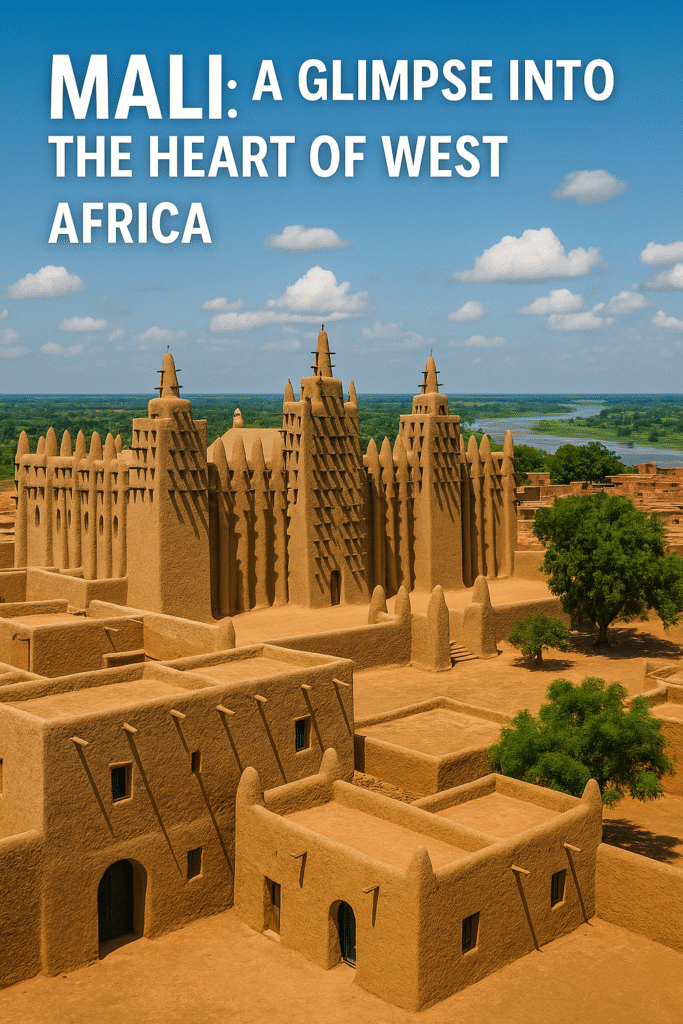Mali, a country located in the heart of West Africa, is a land of rich history, culture, and natural beauty. From its ancient empires to its modern-day challenges, Mali has been a key player in shaping the history of Africa. Despite its recent struggles, Mali remains a symbol of resilience and heritage. In this blog, we will explore the geography, history, cultural significance, and key landmarks of this fascinating nation.

1. Introduction to Mali: Geography and Location
Mali is a landlocked country bordered by Algeria, Niger, Burkina Faso, Ivory Coast, Guinea, Senegal, and Mauritania. Located in the western part of the African continent, it covers an area of approximately 1.24 million square kilometers, making it one of the largest countries in Africa. Despite its vast size, the country is mostly covered by the Sahara Desert, with a climate ranging from arid to semi-arid.
Climate and Terrain
The terrain of mali is diverse, with the Sahara Desert dominating the northern part of the country, while the Soudan region in the south is lush and fertile. The Niger River, which flows through the country from west to east, is a key feature of Mali’s geography. This river not only provides water for agriculture but also serves as an essential trade route.
2. A Rich History: From Ancient Kingdoms to Modern Times
Mali’s history is one of great significance, with a heritage rooted in powerful empires, cultural exchange, and a vibrant society.
The Mali Empire: A Golden Age
One of the most prominent periods in Mali’s history is the Mali Empire, which existed from the 13th to the 16th century. At its peak, the Mali Empire was one of the largest and wealthiest empires in the world, known for its vast territories and immense wealth.
- Mansa Musa, the famous ruler of the Mali Empire, is often regarded as one of the wealthiest individuals in history. His pilgrimage to Mecca in 1324 was a testament to his wealth, as he gave away so much gold that it devalued gold in Egypt for years.
- The empire’s capital, Timbuktu, became a hub of trade, culture, and learning, with the famous Sankore University attracting scholars from all over the Islamic world.
Colonial Influence and Independence
Mali, like many African nations, was colonized by European powers. The country was part of French West Africa under French colonial rule. Mali gained independence from France on September 22, 1960, and became the Republic of Mali. The country has since experienced several political transitions, military coups, and challenges to its democracy.
3. Culture and Traditions: The Heartbeat of Mali
Mali’s culture is an amalgamation of its rich historical influences, vibrant traditions, and diverse ethnic groups. The country is home to a multitude of ethnic communities, including the Bambara, Tuareg, Fulani, Songhai, and Dogon peoples. Each of these groups contributes to the rich cultural tapestry of Mali, with distinct languages, customs, and art forms.
Music and Dance: A National Treasure
Mali is known for its rich musical heritage, and its influence on the global music scene cannot be overstated. The country is the birthplace of many renowned musicians, including Ali Farka Touré and Oumou Sangaré.
- Traditional music: The music of Mali is deeply rooted in the oral traditions of its people. The kora, a string instrument, and the balafon, a type of wooden xylophone, are central to Malian music.
- Dance: Malian dance is an essential part of life in the country. Dance performances are often seen in celebrations, festivals, and rituals, symbolizing both the connection to the community and the divine.
Mali’s Languages
Mali is a multilingual country, with over 13 recognized languages spoken. The official language is French, but the most widely spoken languages are Bambara, Fulani, and Songhai.
4. Landmarks and UNESCO World Heritage Sites
Mali is home to some of Africa’s most breathtaking landmarks, many of which are recognized by UNESCO as world heritage sites.
The Great Mosque of Djenné
The Great Mosque of Djenné is one of the most iconic structures in Mali and a masterpiece of Sudano-Sahelian architecture. The mosque, made of mud brick and plaster, is the largest mud-brick building in the world and is an architectural marvel.
Timbuktu: A Center of Knowledge
The city of Timbuktu is synonymous with learning and culture. Known for its ancient manuscripts and historical importance, Timbuktu once held the largest library in the world, with scholars from across Africa and the Islamic world coming to study. The Timbuktu Manuscripts are now housed in various libraries, preserving the rich intellectual heritage of Mali.
The Dogon Country
The Dogon Country in the central part of Mali is famous for its cliffside villages, ancient customs, and rich cultural heritage. The Dogon people, known for their intricate masks, unique religious practices, and agricultural techniques, have lived in the region for centuries.
5. Mali’s Modern Challenges and Future Outlook
Despite its rich history and cultural heritage, Mali faces several modern-day challenges. The country has been dealing with political instability, economic hardships, and security concerns due to insurgent groups operating in the northern and central parts of the country. In recent years, Mali has seen military coups, and the country’s political future remains uncertain.
However, Mali’s youth and cultural institutions continue to work toward rebuilding the country and preserving its heritage. The international community has also played a significant role in helping Mali address its challenges, particularly in terms of security and development.
6. Conclusion: The Resilience of Mali
Mali is a country that holds a special place in the history of Africa. From the Mali Empire to modern-day Mali, the country has shown resilience and strength in the face of adversity. Its culture, history, and people are its biggest assets, and despite the challenges it faces, Mali remains a nation full of potential and hope for the future.
External Links for Further Reading:
Mexico vs Honduras: The Rivalry That Continues to Ignite Passion